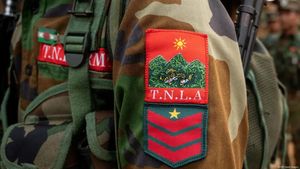NASA is preparing to make a significant announcement this Saturday concerning the return of two astronauts stranded aboard Boeing's Starliner spacecraft. This news follows a tumultuous period marked by delays and technical issues surrounding the spacecraft, which had initially been intended for only eight days of mission time at the International Space Station (ISS). Instead, it has escalated to what could potentially be an extended stay of up to eight months if the astronauts must rely on alternative means of returning to Earth.
The agency has indicated it will assess whether the Starliner is equipped to safely transport veteran astronauts Butch Wilmore and Suni Williams back home. This decision, arriving amid intense scrutiny of Boeing's progress with the Starliner, reflects NASA's broader risk-averse strategy shaped by past incidents like the tragic Columbia disaster.
On June 5, after years of development, the Starliner lifted off for its first crewed mission, carrying Wilmore and Williams to the ISS. What was intended to be a straightforward flight has since plunged Boeing's reputation and the Starliner’s future plans under the microscope, especially after leaks and engine troubles surfaced almost immediately post-launch.
NASA's future plans hinge on outcomes from this review, with the administrator, Bill Nelson, participating directly. Throughout this ordeal, Boeing has worked diligently to address concerns about the spacecraft by providing new test data and reassurance about its safety. Still, there remains significant apprehension due to past hiccups affecting three previous missions since 2019, casting doubts over the Starliner’s reliability.
To mitigate the situation, NASA has crafted contingency plans, one of which involves offering two seats aboard the upcoming SpaceX Crew-9 mission scheduled for launch later this year. If this plan is retained, it could mean Wilmore and Williams wouldn't return until February 2025, pushing their total active mission duration to approximately 268 days if their return is delayed considerably.
If NASA determines the Starliner is unsafe for crew transport, the plan would involve bringing the craft back empty and utilizing the SpaceX Crew-9. This backup option not only serves as insurance against potential failures of the Starliner but also keeps the astronauts on the ISS well-stocked with supplies and prepared for extended durations, as they have ample provisions and designated work to complete until their eventual return.
Several engineers from both Boeing and NASA have engaged actively over recent weeks to verify whether the thrusters and propulsion systems could be trusted for re-entry and landing maneuvers. A positive assessment on the Starliner would allow it to remain docked at the ISS as needed until deemed stable for crew transport.
Boeing's predicament, fraught with technical difficulties and financial setbacks—having incurred $1.6 billion in losses on the Starliner program—comes as it tries to compete with SpaceX, which has successfully conducted numerous crewed missions over four years without incident. Keeping the Starliner crew en route to ISS until the next Crew Dragon available later this year doubles down on the pressure facing Boeing.
Saturday's decision, set for public announcement at around 1:00 PM ET (1700 GMT), is pivotal. It could reshape public perception of Boeing's capabilities as well as highlight the challenges faced within the US space sector as it navigates the aftermath of the Shuttle program's retirement.
While current assessments remain non-committal, insiders hint at the priority on grounding immediate risks linked to the Starliner before making any concrete returns. The ramifications of this situation—both for NASA, the astronauts, and Boeing—mirror the wider, competitive dynamics of the aerospace industry as it stands on the cusp of considerable transformative breakthroughs.



